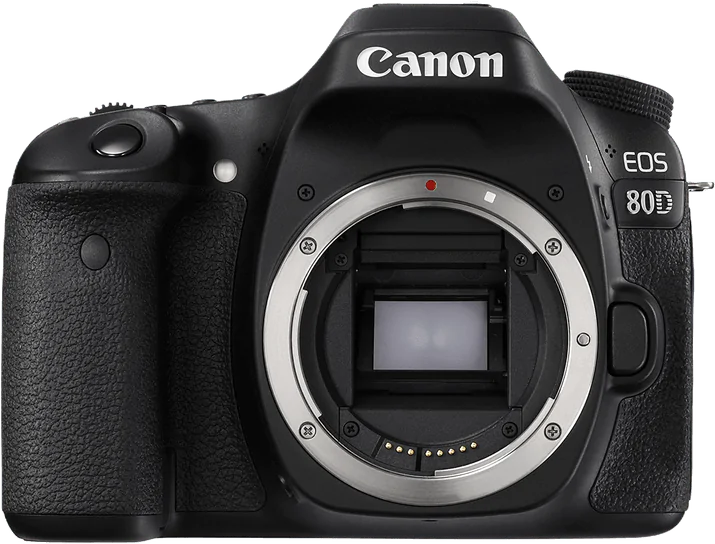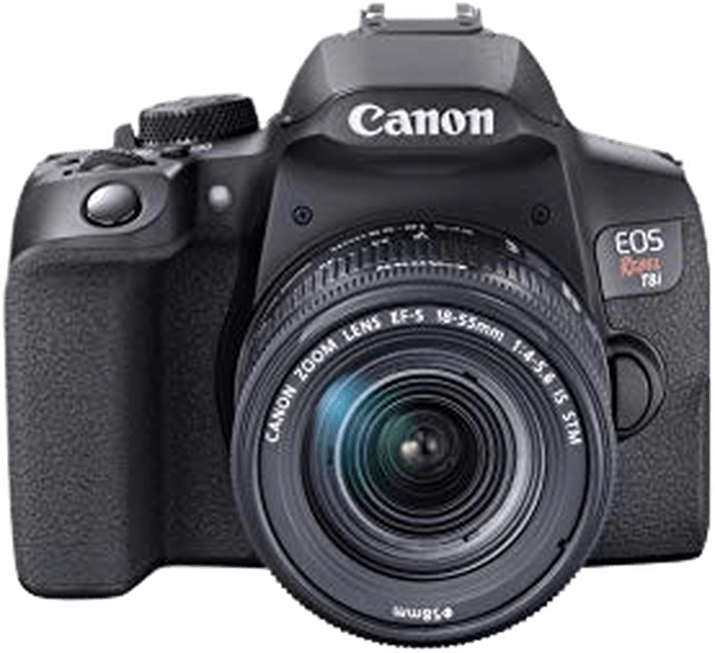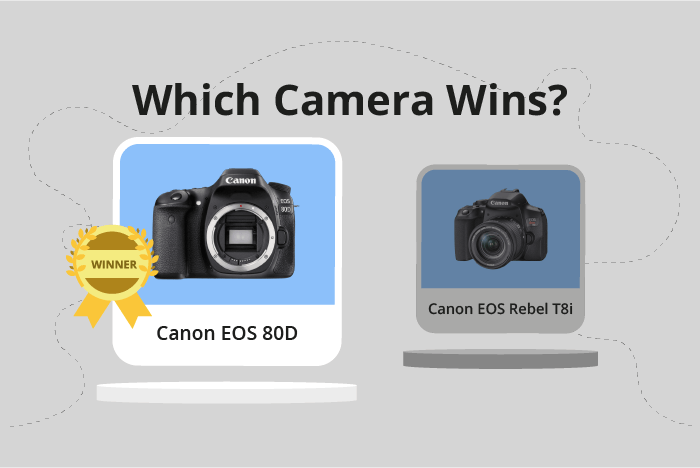Canon EOS 80D vs EOS Rebel T8i / 850D Comparison
Canon EOS 80D

Canon EOS Rebel T8i / 850D

The Canon EOS 80D outperforms the Canon EOS Rebel T8i / 850D with a score of 64/100 compared to 59/100. Both cameras are DSLRs and share similar dimensions: the 80D measures 139 x 105 x 79mm, while the T8i / 850D is slightly smaller at 131 x 103 x 76mm. The 80D, released in 2016, is heavier at 730g, while the T8i / 850D, released in 2020, weighs 515g.
The 80D’s higher score signifies its superior performance and features. However, the T8i / 850D has advantages, such as its lower launch price of $750 compared to the 80D’s $1200 and lighter weight, making it more budget-friendly and portable.
While the Canon EOS 80D offers better performance, the Canon EOS Rebel T8i / 850D is a more affordable and lightweight option for those seeking a capable DSLR camera.
Canon EOS 80D vs EOS Rebel T8i / 850D Overview and Optics
The Canon EOS 80D outperforms the Canon EOS Rebel T8i / 850D in optics with a score of 63/100 compared to 57/100. Both cameras share several specifications, including a CMOS sensor, APS-C sensor size, Canon EF-S lens mount, and lack of image stabilization. However, differences in their megapixels, shooting speed, processor, and DXOMARK sensor scores contribute to the overall disparity in their optics performance.
The EOS 80D has a slight advantage in megapixels with 24.2, while the Rebel T8i / 850D has 24 megapixels. This difference allows the 80D to capture slightly more detail in images. Additionally, the 80D has a higher DXOMARK sensor score of 79, compared to the T8i / 850D’s score of 58. This indicates that the 80D’s sensor performs better in terms of color depth, dynamic range, and low-light capabilities.
On the other hand, the Rebel T8i / 850D offers a faster shooting speed of 7.5 compared to the 80D’s speed of 7. This means the T8i / 850D can capture more frames per second, which is beneficial for action photography. Furthermore, the T8i / 850D has a more advanced Digic 8 processor, while the 80D uses the older Digic 6 processor. This could result in improved image processing and performance for the T8i / 850D.
Despite these advantages for the Rebel T8i / 850D, the Canon EOS 80D remains the better camera in terms of optics due to its higher megapixels and superior sensor performance. The T8i / 850D’s faster shooting speed and advanced processor do not outweigh the 80D’s advantages. Therefore, the Canon EOS 80D is the winner in this comparison of optics.
Canon EOS 80D vs EOS Rebel T8i / 850D Video Performance
The Canon EOS Rebel T8i / 850D outperforms the Canon EOS 80D in video capabilities, with a video score of 83/100 compared to the 80D’s 70/100. Both cameras share some common specifications, such as a max video frame rate of 60fps and built-in time-lapse functionality. However, the T8i / 850D surpasses the 80D in terms of video resolution and dimensions.
The T8i / 850D boasts a maximum video resolution of 4K, which is a significant improvement over the 80D’s Full HD resolution. Additionally, the T8i / 850D’s maximum video dimensions are 3840 x 2160, while the 80D’s dimensions are limited to 1920 x 1080. These factors contribute to the T8i / 850D’s superior video quality and detail, making it the better choice for videographers seeking high-resolution footage.
Despite its lower video score, the 80D still offers reliable video performance. Its Full HD resolution and 1920 x 1080 dimensions can produce good quality video, suitable for casual users or those who do not require 4K resolution. However, it falls short when compared to the T8i / 850D’s capabilities.
Both the Canon EOS Rebel T8i / 850D and the Canon EOS 80D offer solid video performance, but the T8i / 850D’s higher resolution and dimensions make it the clear winner in this comparison. For those who prioritize video quality and detail, the T8i / 850D is the better choice, while the 80D remains a reliable option for casual users.
Canon EOS 80D vs EOS Rebel T8i / 850D Features and Benefits
The Canon EOS 80D and Canon EOS Rebel T8i / 850D both have a feature score of 70/100, showing that they have similar capabilities. They share common specifications, including a 3-inch screen size, 1,040,000-dot screen resolution, touchscreen, flip screen, WiFi connectivity, and no GPS.
The Canon EOS Rebel T8i / 850D has an advantage over the Canon EOS 80D because it features Bluetooth connectivity, allowing for easier and more convenient file transfer and remote control options. This added functionality can be beneficial for photographers who value seamless integration with their devices and a more streamlined workflow.
On the other hand, the Canon EOS 80D does not offer any clear advantages over the Canon EOS Rebel T8i / 850D in terms of features. Both cameras are equal in this aspect, and the decision to choose one over the other will depend on personal preferences and other factors such as price, body design, and specific use cases.
Taking everything into consideration, the Canon EOS Rebel T8i / 850D stands out slightly due to its Bluetooth connectivity. However, both cameras have a similar feature set, making them suitable choices for various photography needs. Ultimately, the decision between these two models will come down to individual preferences and requirements, as well as any differences in price or additional factors not covered in this comparison.
Canon EOS 80D vs EOS Rebel T8i / 850D Storage and Battery
The Canon EOS 80D surpasses the Canon EOS Rebel T8i / 850D in storage and battery, scoring 43 out of 100 compared to the latter’s 35. Both cameras share similarities, with one memory card slot each, accepting SD, SDHC, and SDXC (UHS-I compatible) memory cards, and neither offering USB charging capabilities.
The EOS 80D’s advantage lies in its battery life, providing 960 shots per charge with the LP-E6N battery type. This is 160 shots more than the Rebel T8i / 850D’s 800 shots using the LP-E17 battery. Despite this, the Rebel T8i / 850D doesn’t offer any significant advantages in storage and battery.
Considering these factors, the Canon EOS 80D is the better choice for those prioritizing longer battery life and overall storage and battery performance. However, both cameras offer similar storage capabilities, making either suitable for capturing memories.
Canon EOS 80D vs EOS Rebel T8i / 850D – Our Verdict
Are you still undecided about which camera is right for you? Have a look at these popular comparisons that feature the Canon EOS 80D or the Canon EOS Rebel T8i / 850D:

